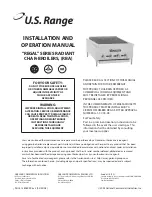
7
INSTALLATION AND OPERATING INSTRUCTIONS
SL 20-115 G2 MODULATING GAS BOILER
SL 14-115 G3, SL 20-160 G3, SL 30-199 G3 MODULATING GAS BOILERS
The Installer must carefully read this manual to ensure that all installation details can
be adhered to. Special attention is to be paid to clearances and access, vent travel and
termination, gas supply, condensate removal and combustion air supply.
The Installer should do a pre-installation check the to ensure that the following precautions
can be observed:
• The boiler should be installed in areas where the combustion air source is not subject
to chemical fouling or agricultural vapors. Exposure to corrosive chemical fumes
such as chlorinated and/or fluorinated hydrocarbons can reduce the life of a boiler.
Cleaners, bleaches, air fresheners, refrigerants, aerosol propellants, dry-cleaning
fluids, de-greasers and paint-removers all contain vapors which can form corrosive
acid compounds when burned in a gas flame. Airborne chlorides such as those
released with the use of laundry detergents are also to be avoided.
• The boiler should be located where water leakage will not result in damage to the area.
If a location such as this cannot be found, a suitable drain pan should be installed
under the appliance. The boiler is not to be installed above carpeting.
• At a new construction site, or during renovations, action must be taken to protect
the boiler from drywall dust or other construction related contaminants; combustion
air should be drawn from a CLEAN source (e.g. outdoors) and the boiler should be
isolated from interior dust sources.
• When the boiler is in operation, the impact of the steam plume normally experienced at
the exhaust terminal of a condensing boiler should be assessed. Generally, intake and
exhaust pipes should terminate at a rooftop or sterile wall location. Boiler condensate
is corrosive. Protective measures must be taken to prevent corrosion damage to
metal roofs or other metal building components in contact with the condensate. Keep
exhaust plumes well away from all building air intakes including those of neighboring
properties.
• In sealed combustion applications, the exhaust outlet should be placed so as to reach
12” minimum above the down-turned intake - to avoid exhaust re-ingestion.
• For sidewall venting options: Both the inlet and exhaust terminations should normally
be located on the same plane (side) of the building. The elevation of both pipes can
be raised in “periscope style” after passing through the wall to gain required clearance
above grade and snow level.
• If the indoor combustion air option is used, ensure combustion air openings to the
boiler room remain unblocked and free of obstructions.
• Examine the condensate outlet to ensure proper disposal of condensate will occur
during operation. If condensates are to be discharged into building drain piping
materials that are subject to corrosion, a neutralization package must be used.
• Ensure that the pressure relief valve will be installed with no valves or other means of
isolation between its inlet and the boiler. Make sure the relief valve outlet will be piped
with unobstructed piping (minimum 3/4” diameter) to a safe discharge location.
• In locations where power supply quality varies or is unstable, installation of surge
protection and power conditioners up to and including battery back-up uninterrupted
power supply devices should be considered.
WARNING
Do not use this boiler if any
part has been under water.
Immediately call a qualified
service technician to inspect the
boiler and to replace any part
of the control system and any
gas control that has been under
water.
DANGER
Should overheating occur or the
gas supply fails to shut off, do
not turn off or disconnect the
electrical supply to the pump.
Instead shut off the gas supply
at a location external to the
appliance
CAUTION
Care must be taken to properly
size the boiler for its intended
use. Prolonged full fire run time,
over-sizing or under-sizing, and
incorrect flow rates through
the boiler can lead to increased
maintenance costs, equipment
stress and premature failure.
WARNING
If the boiler can become exposed
to fluid temperatures below 34°F
(1°C), a method of protection to
prevent freezing of condensate
should be employed. Contact the
factory for further information.
Summary of Contents for SL 14-115 G3
Page 71: ...6 3 DIAGRAMS SL 14 115 G3 SL 20 160 G3 SL 30 199 G3 MODULATING GAS BOILERS...
Page 73: ...6 5 DIAGRAMS SL 14 115 G3 SL 20 160 G3 SL 30 199 G3 MODULATING GAS BOILERS...
Page 75: ...6 7 DIAGRAMS SL 14 115 G3 SL 20 160 G3 SL 30 199 G3 MODULATING GAS BOILERS...
Page 81: ...SERVICE RECORD DATE LICENSED CONTRACTOR DESCRIPTION OF WORK DONE...
Page 82: ...NOTES...
Page 83: ...NOTES...








































